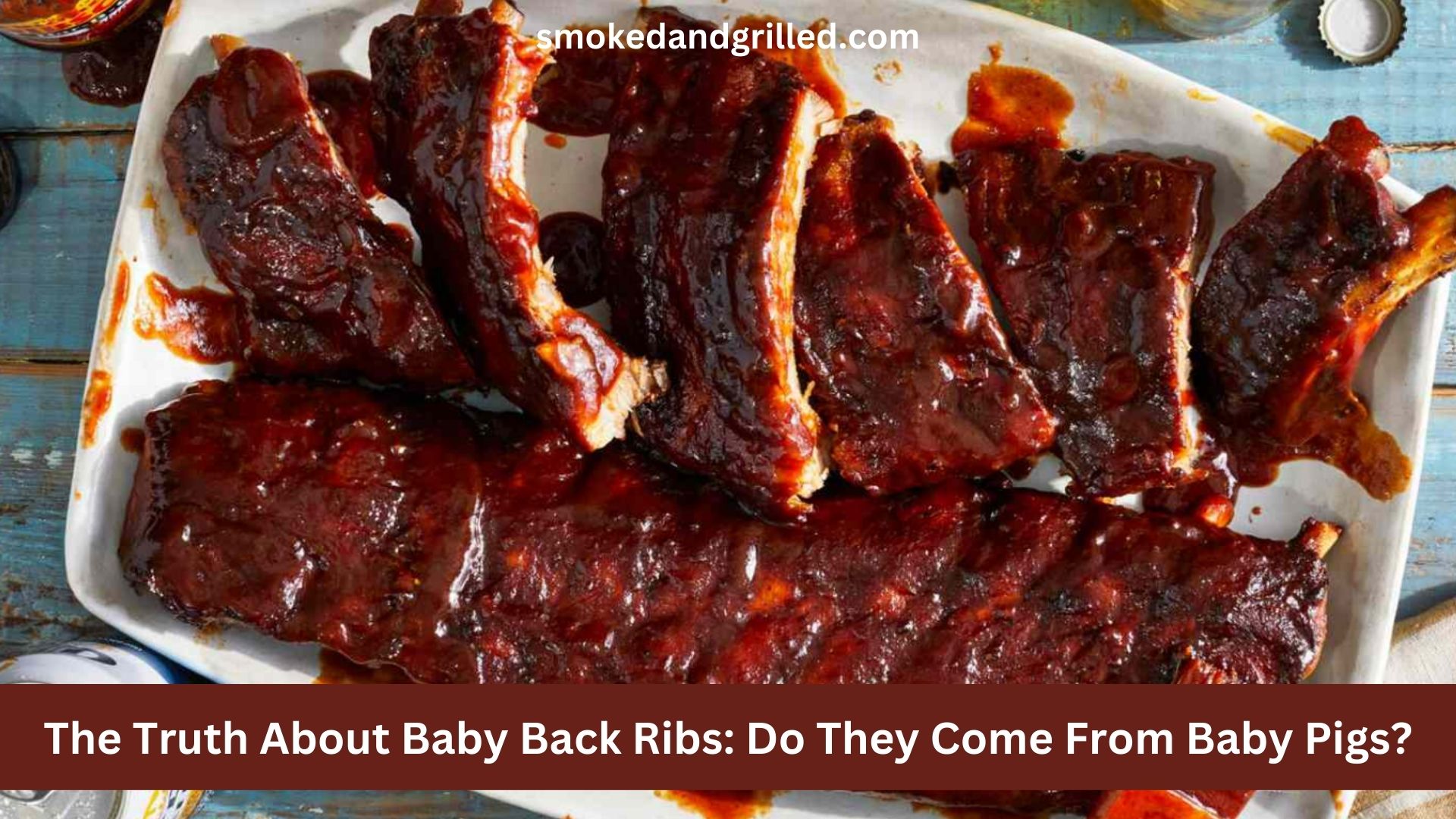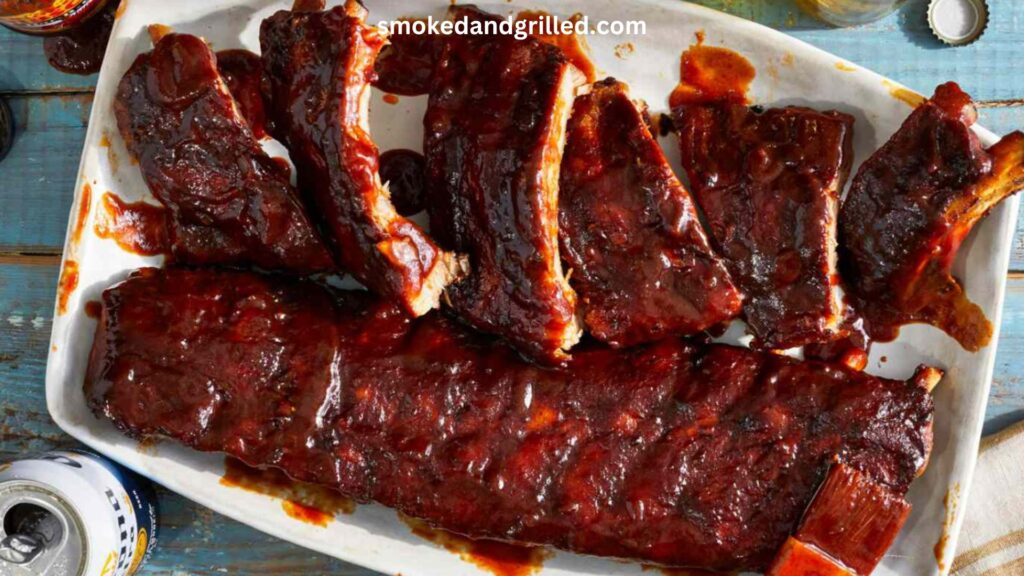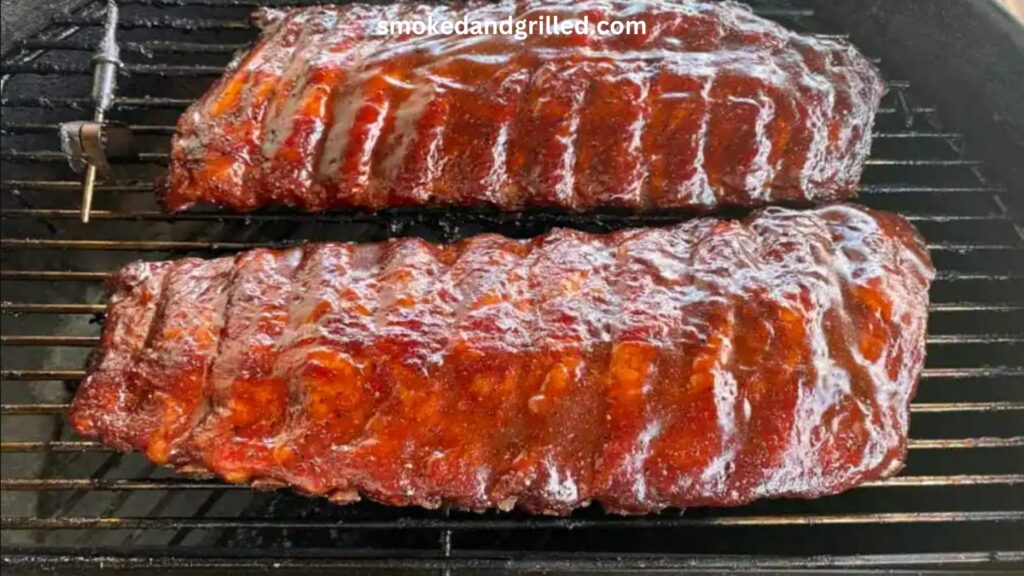No, baby back ribs do not come from baby pigs. The term “baby back ribs” refers to a specific cut of pork ribs that are taken from the upper portion of a pig’s back near the spine.
These ribs are highly sought after for their tenderness and flavorful meat, making them a popular choice in many barbecue and culinary dishes.
Related Posts:
- How To Smoke Baby Back Ribs On A Charcoal Grill?
- How Long To Smoke Baby Back Ribs At 225? ( All You Need To Know)
- How Long To Smoke Baby Back Ribs? (An Easy Guide)
The History Of Baby Back Ribs
The origins of baby back ribs can be found in the United States, particularly in the South, where barbecue has a long history.
In the 20th century, “baby back” became a common way to talk about a specific cut of pork ribs.
Ribs have been a mainstay of American barbecue for a long time, and different cuts and styles have developed over time.
Baby back ribs are the ribs that are closest to the backbone of the pig. They are smaller and more tender than spare ribs.
The word “baby” was used to describe their small size, and the word “back” meant that they were near the backbone.
Baby back ribs became very popular around the middle of the 20th century when barbecue restaurants and fans started touting them as the best cut.
Baby back ribs are popular with people who like barbecue because they have tender meat and a rich flavor.
Most of the time, they are seasoned with a dry rub or barbecue sauce and then slow-cooked or grilled until done.
Baby back ribs are still liked by people who like tender, flavorful meat.
They have become an essential part of barbecue contests, backyard cookouts, and restaurant menus, adding to the rich culinary history of American barbecue.
What Are Baby Back Ribs?
Baby back ribs are a specific cut of pork ribs that come from the upper part of a pig’s back, near the spine.
Because they are smaller than other rib cuts, they are called “baby back” ribs.
Baby back ribs are known for having meat that is tender, juicy, and full of flavor.
They have a higher ratio of meat to bone than other rib cuts, which makes barbecue fans and chefs want them a lot.
Most of the time, the meat is lean and has a slightly sweet taste.
To make them taste better before cooking, you can season them with a dry rub or marinate them in sauces.
Baby back ribs are usually served as the main dish and are often served with barbecue sauce.
They are a popular choice at barbecue restaurants and backyard cookouts.
The Age Of A Pig Used For Baby Back Ribs
The age of a pig whose back ribs are used for baby back ribs can vary, but it doesn’t always show how old the pig is.
Instead, it refers to how small and tender the ribs are.
Baby back ribs come from the upper part of a pig’s back, near the spine.
Compared to other rib cuts, they tend to be smaller and more tender.
Pigs used for baby back ribs can be anywhere from a few months to over a year old, depending on things like the breed, how the farm is run, and how big the ribs should be.
The meat’s tenderness and quality depend more on the pig’s diet, its genes, and how the ribs are prepared and cooked than on how old the pig is.
It’s important to remember that “baby back ribs” is a cooking term, not a way to tell how old the pig is.
The Debate: Are Baby Back Ribs From Baby Pigs?
Below is the Table of Arguments;
| Side | Argument |
| Pro-“Baby Pigs” | “The name ‘baby back ribs’ implies that they come from young and tender baby pigs.” |
| Con-“Not Baby Pigs” | “Baby back ribs are named after the size and tenderness of the ribs, not the pigs.” |
Act 1: Different Points Of View
(Scene: A large debate hall with a table in the middle and a room full of people who are eager to watch.)
Host
Welcome to the most-anticipated debate about where baby back ribs come from, ladies and gentlemen!
Let’s introduce our spirited debaters. Please say hello to Miss Porcina Squealers, who is here to defend the idea that baby back ribs come from baby pigs.
On the other hand, Mr. Ribmaster Smokehouse supports the idea that baby back ribs don’t come from baby pigs.
Act 2: Putting The Cases Forward
Scene: The debaters walk onto the stage, ready to make their points.
Arena: (With Style)
“The name “baby back ribs” tells you that these tasty ribs come from young, tender baby pigs. It’s a sign of how soft and delicate their taste is.”
Ribmaster: (Sure Of Himself)
“Ah, but dear Porcina, the name “baby back ribs” doesn’t mean how old the pig is. It’s just a way to describe how big and tender the ribs are. They can come from pigs of many different ages.”
Act 3: Rebuttals And Arguments Against
Scene: Two people argue against each other’s points in a lively exchange.
Ribmaster: (Trying To Persuade)
“The word “baby” might be misleading, but the story is in the cut.
No matter how old the pig is, the baby’s back ribs are tender because they are small and close to the spine.
Act 4: Testimony From Experts
Scene: Expert witnesses take the stand and talk about what they know.
Host:
We call on our experts to help us understand this debate. Dr. Swinefield, please talk about what you think.
Dr. Swinefield says,
“The term ‘baby back ribs’ does not refer to the age of the pig. Instead, it means a certain cut of ribs.” Size, tenderness, and flavor don’t depend on how old the pig is, but on which part of the ribs is chosen.
Act 5: Coming To A Fair Settlement
Scene: The people arguing and the experts come together to find a middle ground.
Arena: (In A Humble Way)
“I have to admit that the phrase “baby back ribs” doesn’t always mean piglets.
The age of the animals shouldn’t be as important as the cut and how tender it is.
Ribmaster: (With Grace)
“You’re right, Porcina. Let’s celebrate how good baby back ribs are by enjoying their flavors and not making assumptions about where they come from.
What Is The Nutritional Value Of Baby Back Ribs?
Baby back ribs are delicious and rich, but they also have a lot of calories and fat.
The exact nutritional value depends on things like how it was cooked and whether or not it had any extra seasonings or sauces.
Here is a general look at what baby back ribs have in them per 3.5-ounce (100-gram) serving:
- Calories: Between 250 and 300 calories.
- Protein: About 20 to 25 grams of protein, which helps build and repair muscles.
- Fat: Baby back ribs have about 20–25 grams of fat per serving, which is pretty high. This includes saturated fat, which is unhealthy and should be eaten in small amounts.
- Carbohydrates: A serving of baby back ribs has less than 1 gram of carbohydrates.
- Vitamins and minerals: They have small amounts of iron, zinc, vitamin B12, and other vitamins and minerals.
What Are Some Alternative Pork Cuts For Baby Back Ribs?
If you’re looking for other pork cuts that taste and feel like baby back ribs, here are a few options:
Spare Ribs
Spare ribs come from the lower part of the pig’s ribcage and have more meat and fat than baby back ribs.
They have a lot of different tastes and textures.
Spare ribs are usually bigger and have more connective tissue than baby back ribs, which can make them a little bit chewier.
St. Louis-Style Ribs
St. Louis-style ribs are like spare ribs, but they are trimmed and cut into squares.
They have more meat, and the cartilage and sternum bone have been taken out.
This gives them a more even and consistent shape. If you want ribs with more meat and less cartilage, you might like St. Louis-style ribs.
Rib Tips
The ends of spare ribs that have a lot of cartilage are called rib tips.
Even though they are small, they are juicy and full of flavor. The meat on rib tips is often prized because it is soft and tasty.
Country-Style Ribs
Country-style ribs don’t come from the pig’s ribs but from its shoulder.
They are meaty cuts with the bone still in them. They look more like pork chops than traditional ribs.
Country-style ribs are known for being tender, and they can be a great choice if you want a pork cut with a bit more meat.
Ribeye Chop
A ribeye chop, also called a rib chop or pork ribeye, is a pork chop with a bone still in it that comes from the rib section.
It has well-marbled meat that makes it tender and juicy to eat.
Even though ribeye chops are not technically ribs, they taste and feel a lot like ribs.
How Can I Cook The Perfect Baby Back Ribs?
To get tender and flavorful baby back ribs, you need to plan and prepare them carefully and use a variety of cooking methods.
Here is a step-by-step guide with headings and bullet points to help you:
How To Choose And Cook The Ribs?
- Choose fresh, high-quality baby back ribs with good marbling and a few extras.
- Take the membrane off the side of the ribs where the bone is. This will make them more tender and help them soak up more flavor.
- Rinse the ribs in cold water and pat them dry with paper towels.
How To Season The Ribs?
- Use a lot of dry rubs to improve the taste. Depending on what you like, a typical dry rub can have salt, pepper, paprika, garlic powder, onion powder, and other spices.
- Massage the dry rub gently into all sides of the ribs to make sure they are all covered.
- Let the ribs sit in the fridge for at least 1 to 2 hours, or better yet, overnight, so that the seasoning can soak into the meat.
Getting Ready For The Grill Or Oven
- If you’re using a grill, heat it to 275°F to 300°F for indirect grilling.
- Put a drip pan under the grates to catch any juices that might fall through.
- Preheat the oven to 275°F if you’re going to use it. Aluminum foil makes it easy to clean up a baking sheet.
How to Cook the Ribs?
- Put the ribs on the grill or in the oven with the bone side down.
- For grilling, cook the ribs with the grill lid closed over indirect heat, away from direct flames.
- Keep the temperature between 275°F and 300°F at all times.
- To bake in the oven, put the ribs on the middle rack of a preheated oven.
Monitoring And Basting
- Grill: Cook the ribs for about 2.5 to 3 hours, turning them every so often and checking to see if they are done.
- During the last 30 minutes of cooking, baste the ribs with your favorite barbecue sauce in thin layers to make a flavorful glaze.
- In the oven, bake the ribs for about 2.5 to 3 hours, basting them with barbecue sauce every so often during the last 30 minutes.
Checking If It’s Done And When To Rest
- Use the bend test to see if something is done
- Grab the ribs with tongs and give them a gentle shake.
- If they bend a little and start to crack, they are done.
- Once the ribs are done, take them off the grill or out of the oven and loosely cover them with foil.
- Let them sit for 10 to 15 minutes so the juices can move around.
Serving And Taking Pleasure
- Cut the ribs into separate pieces between the bones.
- If you want, you can serve extra barbecue sauce on the side with the ribs.
- Enjoy your perfectly cooked baby back ribs with your favorite sides, and enjoy the tender, flavorful meat!
FAQs
Is It True That Baby Back Ribs Come From Young Pigs?
No, baby back ribs are not only made from pigs that are very young.
The word “baby” in the baby’s back ribs has nothing to do with how old the pig was.
Instead, it refers to the size and tenderness of the ribs.
Baby back ribs come from the upper part of the pig’s back, near the spine.
Compared to other rib cuts, they are smaller and more tender. Different ages of pigs can make them.
How Can I Eat Baby Back Ribs In A Moral Way?
To eat baby back ribs in a moral way, think about the following:
- Look for pork that was raised in an ethical way and came from a sustainable source.
- Choose meat from farmers or suppliers who care about animal welfare, farm in a responsible way, and care about the environment.
- Choose organic or pasture-raised pork, which is usually raised in a way that is better for the animals and the environment.
- Help local farmers or small-scale producers who treat their animals well and are honest about how they farm.
- Look for certifications like “Animal Welfare Approved” or “Certified Humane” to make sure there are higher standards for animal welfare.
What Are Some Popular Brands Of Baby Back Ribs And Restaurants That Serve Them?
Baby back ribs are served by a number of well-known brands and restaurants. Here are some well-known choices:
- Famous Dave’s is a chain of barbecue places that are famous for their baby back ribs.
- Tony Roma’s is a chain of restaurants known for their baby back ribs, which are often served with their own special sauce.
- Chili’s is a casual restaurant where baby back ribs are one of the most popular items on the menu.
- Baby back ribs are on the menu at Applebee’s, which is a chain restaurant.
- Dickey’s Barbecue Pit is a chain known for its baby back ribs and other smoked meats.
It’s important to know that the availability of baby back ribs may change depending on where you live, and that local barbecue joints may also serve tasty baby back ribs.
What Kind Of Effect Does Making And Eating Baby Back Ribs Have On The Environment?
Several things can have a big effect on the environment when making and eating baby back ribs, such as:
- Raising livestock, like pigs, needs a lot of land for making feed and raising the animals. This causes trees to be cut down and animals to lose their homes.
- Raising pigs can cause a lot of methane and nitrous oxide to be released into the atmosphere, which contributes to climate change.
- There is a lot of water used in pig farming, like watering feed crops and taking care of the animals.
- If pig waste, like manure, is not handled properly, it can pollute water and hurt the environment.
To lessen the damage to the environment, choose pork that is grown in a sustainable and ethical way by farmers who use techniques like regenerative agriculture, water conservation, and waste management systems.
What Will Happen To The Baby’S Back Ribs?
In the future of baby back ribs, there may be more focus on ethical and sustainable practices.
As people become more aware of what they eat, there is a growing demand for meat that comes from responsible sources, including pork.
This has led to the rise of different ways to farm, like regenerative agriculture, organic production, and systems where animals are raised on pasture.
Also, improvements in food technology could make it possible to make pork from plants or grow it in a lab instead of using real pork.
These alternatives could have similar tastes and textures while having less of an effect on the environment and being better for animals.
Conclusion
In conclusion, it’s a mistake to think that baby back ribs come from baby pigs. Baby back ribs don’t come from young or baby pigs.
Instead, they are a specific cut of pork ribs that come from the top part of the back of a pig.
The word “baby” in “baby back ribs” refers to how small and tender the ribs are, not how old or big the animal is.
These ribs are known for being tender and tasty, which makes them a popular choice for barbecuing and cooking.
Knowing where baby back ribs come from clears up any questions about where they come from.
Also Read:



